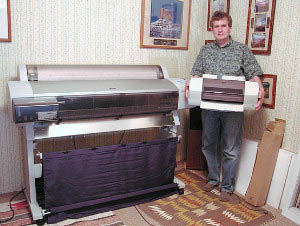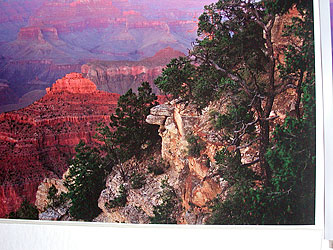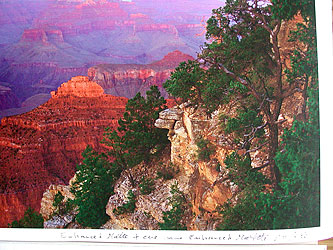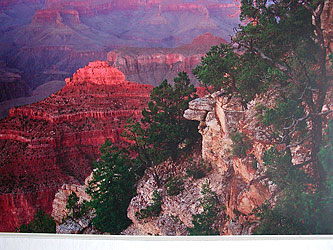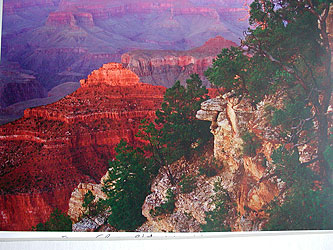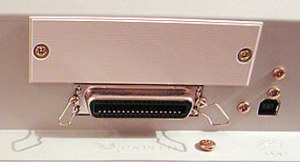|
|
Printing Insights #013Epson 9600 Diary
|
||||||||||
| Part 2 |
||||||||||
| We are very pleased that Alain Briot shares his experience with his new Epson 9600 printer. Alain is a very well known professional landscape photographer. Alain lives in Arizona. |
||||||||||
| The diary always has the latest entry on top | ||||||||||
| 7/12/2002 | ||||||||||
| I came back from a week-long trip yesterday and did
not have time to do any additional printing or testing. However, I did
find a few minutes to do a printhead test to see if the inks dried in
the head while I was away and if there was a need to do a cleaning cycle.
To my great pleasure the printhead test came out perfect, with none of
the nozzles clogged whatsoever, and this right after the printer was turned
on. This is good news as I live in Arizona and the outside temperature
here reaches 100 degrees fahrenheit. I do leave the swamp cooler on at
all times while I am away since it adds humidity to the air and keeps
the temperature at 75 degrees fahrenheit or so. However, I was curious
how this arrangement would work with pigment inks which are thicker than
dyes and more prone to clogging.
I had many questions about profiling and about where to find profiles. The custom profiles I used for the tests posted in my diary were made by Uwe Steinmueller using the Gretag McBeth Eye One (UV unit) profiling system. I found these profiles to work very well for the 9600. Also, an article summarizing the breakthroughs introduced by Ultrachrome
inks and by the new 9600, 7600 and 2200 printers is now online at This is all for today as I have to leave again for a show. I will be back in about 12 days so if you have any questions you will have to be patient and wait until my return to get an answer. Thank you to all for your interest in this diary. From the feedback I got so far you seem to find it quite helpful which is wonderful. |
||||||||||
| 7/2/2002 | ||||||||||
| I have been working with the 9600 for over a week now and it is time to take a break. I will therefore be away for several days and there will not be any diary entries during this time. When I return, I will proceed with testing new profiles for the 9600. A useful tool if you work on a Macintosh is the Drop€ColorSyncProfile utility which will make profiles created on a PC ColorSync compatible and thus usable on a Mac. An article on the 9600 and on Ultrachrome inks will be published on "The Luminous Landscape" in the coming days so keep an eye out. This article summarizes my conclusions after working extensively with the 9600 and Ultrachrome inks. The information contained in the article is not redundant with what I wrote in this diary. Happy Fourth of July to everyone! I'll talk to you again when I come back. |
||||||||||
| 7/1/2002 | ||||||||||
| Today I printed in black and white. I was curious to see the quality of black and white prints on the 9600 and even more curious to find out if there would be a color cast on these prints as is sometimes the case with inkjet printers and monochrome images. Here is a run down of my approach today. The methodology:
The results: To my delight all black and white prints printed without any noticeable color cast. The prints done with the Epson profile printed warmer than the prints done with the Eye One profile. The Eye One profile prints were very neutral. However, I personally like slightly warm black and white prints (the way selenium toning gives a slight warms to chemical prints) so I personally lean towards the prints done with the Epson Profile. However, if I want a completely neutral print the option is there and I just have to use the Eye One profile. Both the prints done on Enhanced Matte and on glossy Heavy Weight came out neutral. I did not have to do any curve adjustments in photoshop. The slight warm tone I just mentioned is really not a color cast, rather a subjective preference. As a matter of fact until I placed the prints done with each profile next to each other I could not tell the Epson print was warmer. To my eye, without a point of reference, it looked perfectly neutral. I tried to photograph these prints but the differences are too subtle to be represented accurately in a photograph. I was concerned with the lack of the Grey Balancer, in which I had placed a lot of hope and which will apparently be available with the 2200, Epson's desktop Ultrachrome printer. However, given how neutral black and white prints come out on the 9600 there is really no need for the Gray Balancer software utility. |
||||||||||
| 6/30/2002 Profiling the 9600 | ||||||||||
| Today I conducted several printing test using new profiles made by Uwe Steinmueller with the Gretag McBeth Eye One profiling software/hardware combination. Comment by Uwe Steinmueller: "Thes profiles were created using one of the latest EyeOne units with an UV cuttoff filter and the EyeOne Match software. Review to follow" These printing tests are visible below in photographs taken with my Epson 3100z digital camera. I prefer to photograph test prints rather than scanning them since, in my estimate, this replicates real-world viewing conditions better. In each of the two sets of photographs below the Eye One profile print is on the right while the Epson profile print is on the left.
The two papers used are Epson Enhanced Matte (top row) and Epson Glossy Paper Photo-Weight (bottom row). Epson Glossy Paper Photo Weight is not actually recommended for the 9600 as it is a dye-based paper. However, since I had the profile I thought I would give it a try. These images are a close approximation of the actual prints although, as you know, it is not possible to show exactly what prints look like on a computer monitor. Anyway, what becomes immediately apparent from these test photographs is that prints done with the Eye One profiles are more saturated, have a more pleasing color balance and show more open shadows than prints done with the factory-supplied Epson 9600 profiles. This is good news! This example also shows how different the same image can print just by changing the profile used. In both examples all the variables were kept constant the only change being the profile used. Again, a major difference here, and for the best which proves how important it is to use the correct profile. The same remarks about color saturation, better shadow areas (more open shadows with better details) as well as better blues and magentas were also apparent when looking at a test print of a Photodisc print target. I did not photograph this print however as the difference were much more subtle and thus harder to see. The changes between the two profiles with an actual photograph are much more dramatic. One more note: when using Image>Mode>Convert to Profile in Photoshop 7 the Eye One profiles give me a screen image which closely matches the actual eye-one profile print. However, with the Epson profile the screen image does not match the print made with this profile as accurately. This is another positive aspect of Eye One profiles since getting an accurate preview image is very important. |
||||||||||
| 6/29/2002 | ||||||||||
| Today I tested Epson's Glossy Paper-Photo Weight. This paper was sent to me by Parrot Digigraphics in replacement of Epson Glossy Paper-Heavy Weight which was sent to me by error. I have only good things to say about this paper. The Epson profile for it is very good and the color density and maximum black density are excellent. Shadows, or dark areas, do not "block up" as much as with Epson Premium Glossy or Premium Luster. Although this paper is not labelled "premium" or "luster" in effect it has the look and feel of a premium paper with semigloss finish. The difference between Glossy Paper Heavy Weight --which is designed for dye inks-- and Glossy Paper Photo Weight --which is designed for Pigment inks-- is night and day. This shows how important it is to choose the media you will be printing on carefully. It also shows how easy it is to make a mistake and print on the wrong paper. These two papers have nearly similar names and thus mistakes are prone to happen. For this reason it is best to use the Epson part number rather than the name when ordering. I also installed a Firewire card on the printer. This should make printing faster, although so far I have not noticed a difference. Since I am printing small images right now this may be why. The ink cartridge level does come up much faster though when invoked in the printer driver.
Talking about ink levels it is important to know the the LCD screen on the printer control panel shows a visual display of each cartridge level at all times: From left to right this shows the black cartridge, light gray, cyan, magenta, light cyan, light magenta and yellow. The last indicator, at far right, shows the fill level of the maintenance tank. As shown here this tank is used up 30% (70% remaining space for ink waste). I find this level quite alarming as this printer has hardly seen any use. If the same use rate continues for the maintenance tank 9600 owners should get ready to change the maintenance tank at the same time as a set of ink cartridges is replaced! In my case I'll have gone from not knowing that maintenance tanks existed to having to stock them up as I do for ink cartridges. Also notice that the light magenta goes down faster than other colors in my case. This is obviously largely based on the type of images printed but it would be interesting to know if other users have noticed the same thing. I did pull out the maintenance tank to look at it and from what I can see it only shows minimal ink fill, not the 30% the software claims to be the case. Here is a photograph of the ink tank taken today so you can judge for yourself: |
||||||||||
| Part 1 of the Diary | ||||||||||
| Alain Briot | ||||||||||
| For Comments post in our News Group |






